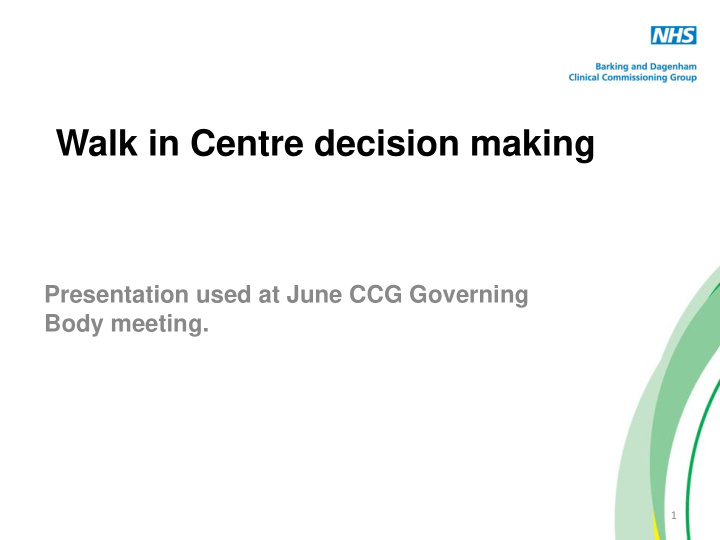



Walk in Centre decision making Presentation used at June CCG Governing Body meeting. 1
Introduction • CCG has identified urgent care as a key priority in its commissioning plans and the walk-in centre (WIC) review is part of a wider programme for improving urgent care • The governing body (GB) in January received a pre-consultation business case on the future model of WICs and agreed to consult on the removal of the WIC at Broad Street and consolidation of services at Barking Community Hospital (BCH) • The GB is today asked to take a decision to close walk in centre services at Broad Street taking into account: • The case for change (previously circulated) • The business case , which has been updated since January to include additional information on primary care capacity and an assessment of WIC closures in England • The consultation report • The equality impact assessment 2
Urgent Care – why we need to change Key challenge for CCG – how to provide effective, high quality and sustainable urgent care services for local people The case for change described a proliferation of different services providing urgent care which were: Difficult for patients to understand and navigate Patients missing out on broader service provided by general practice Had no impact on increasing demand for urgent care Walk in centre review (clinical audit and patient survey) identified: Most of the care provided in WICs could be provided in primary care High level of duplication in system – e.g. second opinions/no active management Patients using WIC because they did not feel they could reliably access their own GP 3
What we heard • Following the options appraisal we consulted on consolidating walk in services on one site – Barking Hospital, Upney Lane • Consultation report sets out in great detail what we heard when we consulted. Key messages: • Many patients recognised the need to reform urgent care services • Many were opposed to losing a walk in service in the borough (although more support for retaining Barking Hospital WIC than Broad Street) • Many patients want greater and more flexible access to general practice – Healthwatch independent survey underlines this which 85% of WIC patients surveyed would rather be seen by their GP if they could get an appointment. • Many stakeholders were concerned about impact of changes 4
Key findings of review • Utilisation of urgent care services is increasing and the current system is not managing demand • Patients value the ability to get easy local access to urgent care - however ease of access to the WIC is driving demand and not reducing activity in other part of the system e.g. A&E • Current services are not integrated – patients are confused about where to go and often do not get their needs met first time • A high proportion of WIC patients attend for conditions that require primary care, a proportion require non-urgent blood tests and around 25% of activity is considered to be duplicate activity (i.e. second opinions/directed back to general practice) • Patients find it difficult to access their GP at the time that they need to - patients registered with general practices around Broad Street are the greatest users of the Broad Street WIC • The limited national evidence on the impact of WICs on other parts of the urgent care system suggests no impact on A&E if a centre closes 5
What does this mean? • The proposal is to decommission WIC services from Broad Street when the current contract comes to an end • The site would continue to provide general medical services with extended access – there is the potential to expand list size further • Blood testing services would also continue to be commissioned and provided locally under appropriate contractual arrangements • Patients would still be able to access one WIC in the borough at Barking Hospital; the specification to be reviewed to enable greater integration with primary care. • A reduction in urgent care activity overall, as duplicate activity is removed from the system and as pathways are more integrated with primary care. • Better access to primary care as the CCG focuses on providing care at the setting that best meets the patients needs 6
Impact • Business case models a system where patients are seen in right setting and duplication is removed from system. This is based on information from the clinical audit on current WIC activity and assumptions on how patients should ideally use the system • It sets out key actions the CCG needs to take to manage risks to the system – making primary care more accessible, diverting patients with primary care needs away from A&E and clear communications to patients. • The business case also reviews the impact of WIC closures in other areas as a way of understanding potential impact. 7
61 61% no treatment/phlebotomy only Diagram illustrating activity flow in proposed approach 8
Next steps • Improve standards of GP access through locality working • Commission additional urgent care appointments through surge scheme (6 month pilot expected to commence in August to inform commissioning plans for 14/15 subject to NHS England approval). • Improve “front door” urgent care centre (UCC) services at Queen’s and King George Hospital (KGH) • Review commissioning of phlebotomy services and ensure local access • Re-procure general medical services for Broad Street with extended access, building in primary care outcome standards (NHSE ) • Review specification for Upney Lane WIC to ensure better integration with general practice 9
Recommend
More recommend